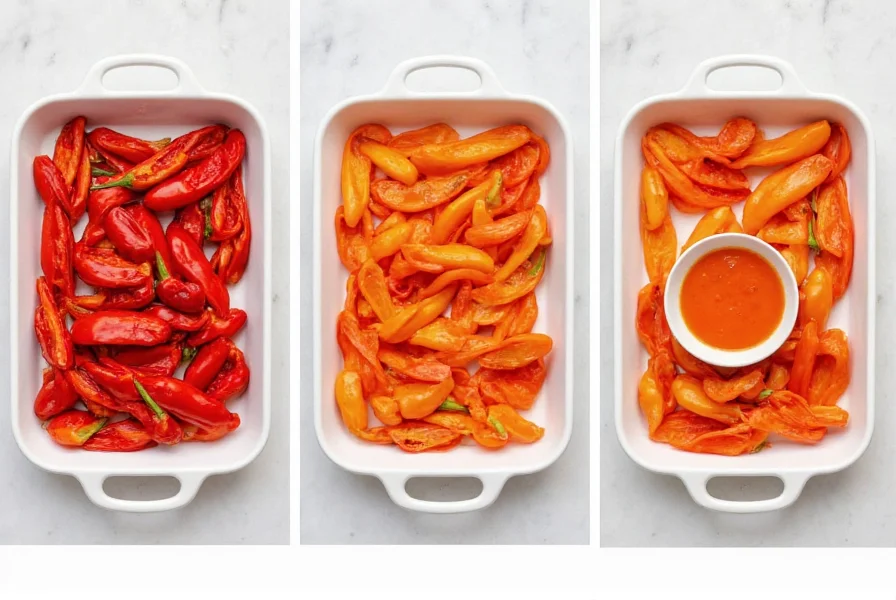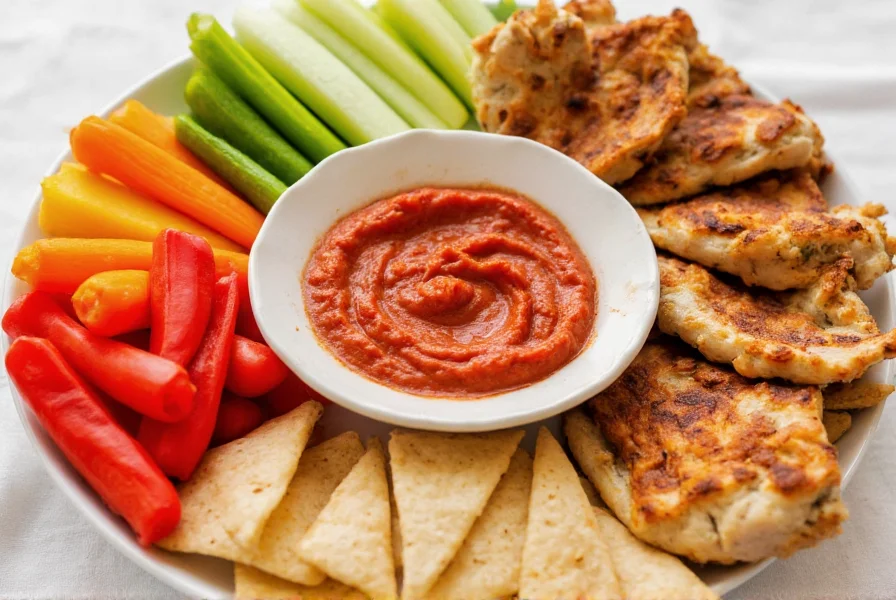If you're looking for an easy roasted red pepper dipping sauce recipe that elevates your snack game, you've found the right guide. This vibrant, nutrient-packed dip transforms simple roasted red peppers into a versatile sauce perfect for vegetables, pita chips, or as a sandwich spread. Unlike store-bought versions that often contain preservatives and excess sodium, homemade roasted red pepper dipping sauce gives you complete control over ingredients and flavor profile.
The Essential Ingredients Breakdown
Creating the perfect roasted red pepper sauce starts with understanding each component's role. While the basic recipe works beautifully, knowing why each ingredient matters helps you customize successfully:
| Ingredient | Function | Substitution Options |
|---|---|---|
| Red bell peppers (roasted) | Provides sweet, smoky base flavor and vibrant color | Poblano peppers for milder heat |
| Garlic | Adds aromatic depth and complexity | Roasted garlic for milder flavor |
| Olive oil | Creates smooth texture and carries flavors | Avocado oil for neutral taste |
| Lemon juice | Provides necessary acidity to balance sweetness | Vinegar or lime juice |
| Seasonings | Enhances overall flavor profile | Smoked paprika, cumin, or herbs |
Step-by-Step Preparation Guide
Follow these detailed instructions for flawless roasted red pepper dipping sauce every time. The entire process takes approximately 25 minutes with 10 minutes of active preparation.
- Roast the peppers: Place whole red bell peppers directly over gas flame, under broiler, or on grill, turning occasionally until completely blackened (about 15 minutes). Alternatively, use jarred roasted peppers for convenience.
- Steam and peel: Transfer blackened peppers to a bowl, cover with plastic wrap, and let steam for 10 minutes. This loosens the skin for easy removal.
- Prepare ingredients: While peppers cool, gather remaining ingredients: garlic, olive oil, lemon juice, salt, and chosen seasonings.
- Blend until smooth: Remove stems, seeds, and skin from cooled peppers. Combine all ingredients in food processor or high-speed blender. Process until completely smooth, scraping down sides as needed.
- Adjust seasoning: Taste and adjust salt, acid, or additional seasonings according to preference. For thinner consistency, add water or additional olive oil one teaspoon at a time.
- Rest before serving: Transfer to container and refrigerate for at least 30 minutes to allow flavors to meld.

Mastering the Roasting Technique
The quality of your roasted red pepper dipping sauce depends significantly on proper pepper roasting. Three effective methods yield excellent results:
- Gas stove method: Ideal for achieving even charring. Place peppers directly on burner grate over medium flame, turning with tongs every 3-4 minutes until uniformly blackened.
- Broiler method: Position oven rack 6 inches from broiler element. Roast peppers on baking sheet, turning every 5 minutes until completely blackened.
- Grill method: Provides subtle smoky notes. Grill over medium heat, turning frequently until charred on all sides.
Regardless of method, the critical step is allowing peppers to steam after roasting. This creates steam that separates the skin from the flesh, making peeling effortless. Never rinse peppers under water to remove skin, as this washes away valuable flavor compounds.
Creative Variations for Different Preferences
Once you've mastered the basic roasted red pepper dipping sauce recipe, experiment with these popular variations that maintain the sauce's healthy profile while adding new dimensions:
- Smoky version: Add 1/4 teaspoon smoked paprika or chipotle powder for depth without overwhelming heat
- Herb-infused: Blend in 2 tablespoons fresh basil, cilantro, or dill for garden-fresh flavor
- Spicy kick: Incorporate 1/2 teaspoon red pepper flakes or a small jalapeño (seeds removed)
- Creamy alternative: Add 2 tablespoons Greek yogurt or tahini for richer texture without dairy
- Mediterranean twist: Include 5-6 pitted Kalamata olives and 1 teaspoon oregano
For those following specific dietary patterns, this versatile sauce adapts beautifully. The naturally vegan and gluten-free base requires no modifications for these diets. To reduce sodium content, simply omit added salt and rely on the natural sweetness of properly roasted peppers.
Perfect Pairing Suggestions
Understanding what to serve with roasted red pepper dipping sauce transforms it from a simple condiment to a meal centerpiece. This vibrant dip complements an extensive range of foods:
- Vegetable platters: Especially excellent with raw carrots, cucumbers, bell peppers, and broccoli
- Bread applications: Use as a sandwich spread, pizza base, or crostini topping
- Protein pairings: Serves as a flavorful accompaniment to grilled chicken, fish, or tofu
- Breakfast enhancement: Swirl into scrambled eggs or spread on breakfast sandwiches
- Pasta integration: Toss with cooked pasta for a quick, flavorful sauce

Storage Guidelines and Shelf Life
Proper storage ensures your homemade roasted red pepper dipping sauce maintains freshness and flavor. Follow these evidence-based guidelines:
- Store in airtight container in refrigerator for up to 5 days
- For extended storage, freeze in ice cube trays then transfer cubes to freezer bag (keeps 3 months)
- Always use clean utensils when serving to prevent bacterial contamination
- Do not leave at room temperature for more than 2 hours
- Signs of spoilage include mold, sour smell, or separation that doesn't reincorporate when stirred
When storing, press plastic wrap directly onto the sauce surface before sealing container. This prevents oxidation that causes discoloration and flavor degradation. The natural acidity from lemon juice helps preserve freshness but doesn't eliminate the need for proper refrigeration.
Troubleshooting Common Issues
Even experienced cooks encounter challenges with roasted red pepper dipping sauce. Here's how to address frequent problems:
- Too watery: Blend in 1/2 teaspoon xanthan gum or additional roasted peppers to thicken
- Too bitter: Balance with 1/4 teaspoon honey or additional lemon juice to cut bitterness
- Lacks depth: Add 1/2 teaspoon toasted cumin seeds or a pinch of smoked salt
- Not smooth: Strain through fine mesh sieve or blend longer with additional olive oil
- Overpowering garlic: Let sauce rest 24 hours for flavors to mellow, or add additional roasted peppers
Remember that flavors continue developing after preparation. Always taste your roasted red pepper dipping sauce after it has rested for at least 30 minutes in the refrigerator before making final seasoning adjustments.
Frequently Asked Questions
Can I use jarred roasted red peppers for dipping sauce?
Yes, high-quality jarred roasted red peppers work well for roasted red pepper dipping sauce. Drain them thoroughly and pat dry with paper towels to remove excess liquid that would thin your sauce. Look for peppers packed in water rather than oil for best results, and choose varieties without added seasonings for maximum recipe control.
How can I make roasted red pepper dipping sauce without a food processor?
You can make roasted red pepper dipping sauce without specialized equipment by finely mincing roasted peppers and other ingredients, then mashing thoroughly with a fork or potato masher. For smoother texture, pass the mixture through a fine mesh sieve using the back of a spoon. While not as smooth as processor-made versions, this traditional method still yields delicious results.
Is roasted red pepper dipping sauce healthy compared to ranch or blue cheese?
Homemade roasted red pepper dipping sauce is significantly healthier than traditional creamy dips. A two-tablespoon serving contains approximately 35 calories, 3 grams of healthy fats, and provides vitamin C and antioxidants from the peppers. In comparison, the same serving of ranch typically contains 140 calories and 14 grams of fat, mostly from unhealthy saturated sources.
Why does my roasted red pepper dipping sauce separate?
Separation occurs when oil and water-based ingredients don't properly emulsify. To prevent this, add olive oil gradually while blending rather than all at once. Including a small amount of lemon juice or vinegar helps create a stable emulsion. If separation happens, simply re-blend the sauce with a teaspoon of cold water to recombine the ingredients.
Can I can roasted red pepper dipping sauce for long-term storage?
Canning roasted red pepper dipping sauce requires proper pressure canning due to the low-acid nature of peppers. For safety, we recommend freezing instead of canning unless you follow tested canning procedures from reliable sources like the National Center for Home Food Preservation. Improper canning can create conditions favorable for botulism.











 浙公网安备
33010002000092号
浙公网安备
33010002000092号 浙B2-20120091-4
浙B2-20120091-4